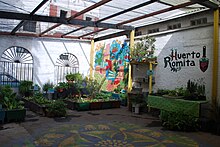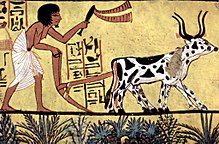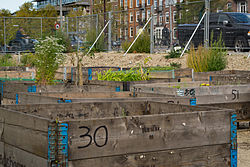Published on Mar 20, 2012
Over 6,000 pounds of food per year, on 1/10 acre located just 15 minutes from downtown Los Angeles. The Dervaes family grows over 400 species of plants, 4,300 pounds of vegetable food, 900 chicken and 1,000 duck eggs, 25 lbs of honey, plus seasonal fruits throughout the year.
From 1/10th of an acre, four people manage to get over 90% of their daily food and the family reports earnings of $20,000 per year (AFTER they eat from what is produced). This is done without the use of the expensive & destructive synthetic chemicals associated with industrial mono-cropping, while simultaneously improving the fertility and overall condition of the land being used to grow this food on. Scaled up to an acre, that would equal $200,000 per year!
To follow the Dervaes and their Urban Homesteading activities, you can find them at http://urbanhomestead.org
Urban and near-urban farming can be highly productive, causing whatever size of land you have to work with to produce with more abundance. It is time to solve hunger worldwide, through creating local food abundance.... Anyone can do it, once you learn how.
Urban agriculture is the practice of cultivating, processing, and distributing food in or around a village, town, or city.[1] Urban agriculture can also involve animal husbandry, aquaculture, agroforestry, and horticulture. These activities also occur in peri-urban areas as well.[2]
Urban farming is generally practiced for income-earning or food-producing activities, though in some communities the main impetus is recreation and relaxation.[3]
Urban agriculture contributes to food security and food safety in two ways: first, it increases the amount of food available to people living in cities, and second, it allows fresh vegetables, fruits, and meat products to be made available to urban consumers. It decreases food deserts.
A common and efficient form of urban agriculture is the biointensive method. Because urban agriculture promotes energy-saving local food production, urban and peri-urban agriculture are generally seen as sustainable agriculture. Another aspect of urban farming, especially in densely populated American cities, is the use of grow-bags to raise a wide range of crops.
Many apartment dwellers with no yards to speak of, or people with very small yards, will set up these bags on a balcony or thin strip of land. Also, many types of hanging bags are available to plant, expanding the area available for planting.
The bags themselves are made from a variety of materials, including canvas, weed barrier fabric, and polyester, all having semi-porus properties so the soil can drain adequately. The term "Bagriculture" was coined in 1998 by Los Angeles animator and amateur archaeologist Rudy Zappa Martinez to describe this type of agriculture.
The recognition of environmental degradation within cities through the relocation of resources to serve urban populations[4] has inspired the implementation of different schemes of urban agriculture across the developed and developing world. From historic models such as Machu Picchu to designs for new productive city farms, the idea of locating agriculture in or around the city takes on many characteristics.
History

Huerto (vegetable garden or orchard) Romita) organization dedicated to urban agriculture located in the La Romita section of Colonia Roma, Mexico City.
Allotment gardens came up in Germany in the early 19th century as a response to poverty and food insecurity.[6] Victory gardens sprouted during WWI and WWII and were fruit, vegetable, and herb gardens in US, Canada, and UK.
This effort was undertaken by citizens to reduce pressure on food production that was to support the war effort. Community gardening in most communities are open to the public and provide space for citizens to cultivate plants for food or recreation. A community gardening program that is well-established is Seattle's P-Patch.
The grass roots permaculture movement has been hugely influential in the renaissance of urban agriculture throughout the world.
The idea of supplemental food production beyond rural farming operations and distant imports is not new and has been used during war times and the Great Depression when food shortage issues arose. As early as 1893, citizens of a depression-struck Detroit were asked to use any vacant lots to grow vegetables.
They were nicknamed Pingree's Potato Patches after the mayor, Hazen S. Pingree, who came up with the idea. He intended for these gardens to produce income, food supply, and even boost self independence during times of hardship. During the first World War president Woodrow Wilson called upon all American citizens to utilize any available open space for food growth, seeing this as a way to pull them out of a potentially damaging situation.
Because most of Europe was consumed with war, they were unable to produce sufficient food supplies to be shipped to the U.S., and a new plan was implemented with the intent to feed the U.S. and even supply a surplus to other countries in need. By the year 1919 over 5 million plots were growing food and over 500 million pounds of produce was harvested.
A very similar practice came into use during the Great Depression that provided a purpose, a job, and food to those who would otherwise be without anything during such harsh times. In this case these efforts helped to raise spirits socially as well as to boost economical growth.
Over 2.8 million dollars worth of food was produced from the subsistence gardens during the Depression. By the time of the Second World War the War/Food Administration set up a National Victory Garden Program that set out to systematically establish functioning agriculture within cities.
With this new plan in action, as many as 5.5 million Americans took part in the victory garden movement and over 9 million pounds of fruit and vegetables were grown a year, accounting for 44% of U.S.-grown produce throughout that time. With its past success in mind and with modern technology, urban agriculture today can be something to help both developed and developing nations.
Facts
- 50% of the world's population lives in cities.[7]
- 800 million people are involved in urban agriculture world-wide and contribute to feeding urban residents.[8]
- Low income urban dwellers spend between 40% and 60% of their income on food each year.[9]
- By 2015 about 26 cities in the world are expected to have a population of 10 million or more. To feed a city of this size at least 6,000 tonnes (6,600 tons) of food must be imported each day.[10]
- 250 million hungry people in the world live in cities[11]
Resource and economic
The Food and Agriculture Organization of the United Nations (FAO), has defined urban agriculture as:[12][A]n industry that produces, processes and markets food and fuel, largely in response to the daily demand of consumers within a town, city, or metropolis, on land and water dispersed throughout the urban and peri-urban area, applying intensive production methods, using and reusing natural resources and urban wastes to yield a diversity of crops and livestock.The definition of urban agriculture as an industry that responds to the nutritional demands of a city, from within that city, with the use and reuse of that city's resources while acknowledging economic and resource use does not reconcile aspects of regional health, food security, and application of grassroots organizations.
(This definition is based on the work of Luc Mougeot of the International Development Research Centre and used in technical and training publications by UN-HABITAT's Urban Management Programme, FAO's Special Programme for Food Security, and international agricultural research centres, such as CIRAD.)
Environmental
The Council on Agriculture, Science and Technology, (CAST) is an international consortium of scientific and professional societies based in Ames Iowa that compiles and communicates credible science-based information to policy makers, media, private sector, and the public. CAST defines urban agriculture to include aspects of environmental health, remediation, and recreation:[13]Urban agriculture is a complex system encompassing a spectrum of interests, from a traditional core of activities associated with the production, processing, marketing, distribution, and consumption, to a multiplicity of other benefits and services that are less widely acknowledged and documented. These include recreation and leisure; economic vitality and business entrepreneurship, individual health and well-being; community health and well being; landscape beautification; and environmental restoration and remediation.Modern planning and design initiatives are more responsive to this model of urban agriculture because it fits within the current scope of sustainable design. The definition allows for a multitude of interpretations across cultures and time. Frequently it is tied to policy decisions to build sustainable cities.[14]
Food security
Access to nutritious food is another perspective in the effort to locate food and livestock production in cities. With the tremendous influx of world population to urban areas, the need for fresh and safe food is increased. The Community Food Security Coalition (CFSC) defines food security as:[15]All persons in a community having access to culturally acceptable, nutritionally adequate food through local, non-emergency sources at all times.
Source: Wikipedia
TTFN
CYA Later Taters
Thanks for watching.
Donnie/ Sinbad the Sailor Man






No comments:
Post a Comment